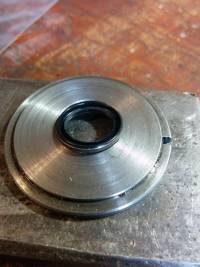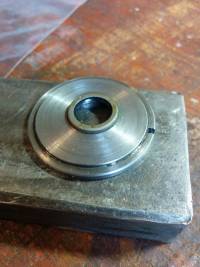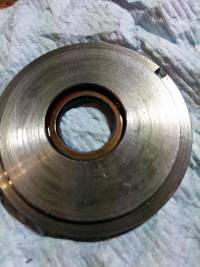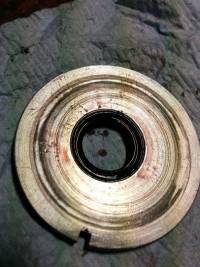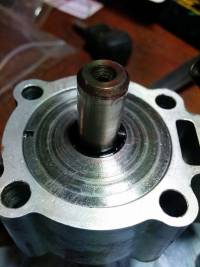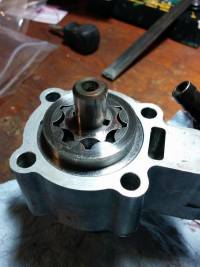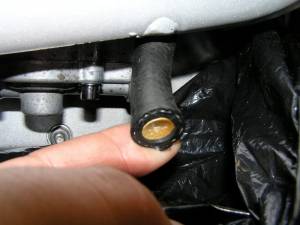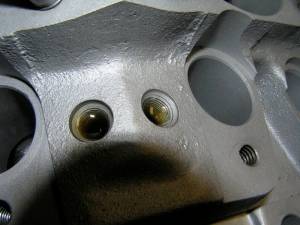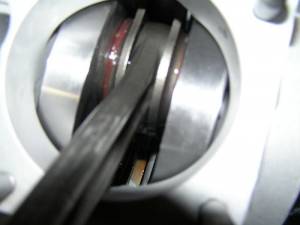Table of Contents
This is an old revision of the document!
IH: Oiling & Lubrication - Sub-03H
77-85 Oil Pump Assembly
(page under construction)
Build Kits / Parts
No build kit was ever assembled / sold from the factory according to the parts catalogs. So individual pieces were sold.
You can search individual part numbers on the net for seals and gaskets.
Or you can search for aftermarket parts / kits.
MAKE SURE THE SEALS MATCH YOUR PUMP when using aftermarket parts.
Current “kits” tend to have “current parts” in the them.
The “current” oil pump is the L83-85 pump (sold for 77-85 when the 77-E83 pump was discontinued).
If you have the older style pump, the L83-85 seal between the plates won't work on the earlier plate as it is pressed into it's matching plate.
Or James Gaskets makes a seal kit (JGI-77-XL).
- It appears to come with:
- Pump to case gasket
- Pump cover O-ring
- (2) separator plate seals (77-E83 and L83-85)
- Both check valve O-rings
- Retainer ring
- Pump housing pin
Outer plate Seal (12036A)
Installing the Oil Pump
Prior to installing the pump
It is assumed that before installing the oil pump, it has been opened up, inspected, measured for wear, lubed and reassembled.
This is normal maintenance for a gerotor type oil pump and should be done from time to time especially if you have no personal history with the oil pump.
If you just bought the bike or oil pump, never assume this has already been done by the P.O. or whoever you bought it from.
If the pump has been in service for “years without problems”, it's still a very good idea to pull the pump apart for inspection when you can.
- Make sure the internals match the pump housing and cover before installing a gerotor oil pump on an Ironhead.
- There were basically 2 different style oil pumps from 1977 to 1985; (1977-E1983 style and L1983-1985 style).
There were many part number changes for pump assemblies which mainly amounted to hose fitting changes although there were housing changes also.
But a big no-no is mixing internals of the two different styles of pumps without the knowledge of what the factory changes were. - The part numbers are not cast or stamped into the oil pump or it's internals so you cannot match parts catalog numbers to a used oil pump.
- Rule of thumb (from the MoCo) on mixing gerotor oil pump internals:
Any 1977-1985 oil pump can be mated to 1977-1985 cases as a unit. Mixing internal parts gets a little tricky though.
77-E83 gerotors can be used in L83-up pumps. L83-up gerotors can only be used in L83-up style pumps.
Click Here to read more specific information on the L83 oil pump changes.
There are also pics of the chamfered and non chamfered gerotors on that page if you scroll the page.
- Make sure the gearshaft seal is the correct one for the outer plate.
- There were 2 different outer separator plates (next to the feed gerotors) used from 77-85 with different IDs.
Each has it's own type gearshaft seal that must be used with it.
Each plate will fit any 77-85 oil pump as a set with it's specific seal (can't mix and match gearshaft seals).
- Make sure the spring washer is installed in the correct orientation.
- If the spring is installed upside down, the fingers won't fit right inside the cupped area of the inner plate.
That could affect spring tension and even pressure on the gerotors resulting in non-horizontal wear on the aluminum mating surfaces.
- Make sure the outer separator plate is seated properly before installing the cover screws.
- One problem with assembling an IH gerotor pump is the roll pin in the oil pump housing.
The lower (outer) spacer plate has a slot cut into it that goes around that pin in the housing. 2)
The uncompressed spring pushes this connection outward and with a loose cover, the outer plate will spin over the top of the pin.
If the plate rides on the end of the pin when the cover is installed then tightened down, this will lock the pump to the point of damage with the motor running.
Best to assemble the pump with duct tape until you get it mounted to keep the spacer from moving.
Else the pump can lock up once the bolts are in due to the washer not being sunk into the housing properly. - What happens when the outer plate gets out of alignment (or turned even slightly) is the cover presses the plate onto the roll pin in the housing.
Consequently, one side of the feed gerotors are pressed into the assembly more than the other side.
Serious damage to the outer plate and possible seized gerotors is certain with this scenario and that damage will flow right to your crank. 3)
The gerotors depend on two main horizontal plains each. Each rotate on:
A flat metal surface (plate) that is pressed against them by the spring washer and the flat aluminum surface in the body or the cover.
With all things equal, the metal plate can wear down the thickness of the adjacent gerotors.
And the gerotors can wear the aluminum mating surface as well.
Gearshaft resistance
Once the oil pump is installed and tightened up, the gears will be hard to turn by hand.
This is normal and because of the spring washer between the upper and lower separator plates.
The resistance felt at the driveshaft gear is only generated from pressure against the feed gerotors. 4)
In fact, with the pump removed from the engine, assembled with all internals (a couple nuts and bolts to clamp the cover to the housing);
1977-1990 oil pumps have to be turned with 2 fingers… and some guff. It will be difficult (but doable) to turn.
1991-up oil pumps have no spring washer, only one separator plate and can be spun using 1 finger to roll the gearshaft around.
If you were to remove the spring between the plates on 77-90 pumps, the gearshaft would be easily turned with one finger.
But you can't run 77-90 oil pumps without the spring between the plates.
The pump housing and cover on these are both designed / machined to include that spring washer.
It is solely the spring that makes the resistance on 77-90 pumps.
The pump housing has two separate bores for feed and return gerotors with the return set being smaller in diameter.
With the return side on top, the divide between the two housing bores creates a “shelf” where the small bore stops and the larger feed side bore begins.
The inner separator plate sits against that “shelf” between the bores, then the spring washer and outer separator plate go on.
With this design, the return gerotors are shielded from spring pressure since they are above that divide between the bores.
During operation, the inner plate is nestled against the “shelf” (not touching the return gerotors).
The feed gerotors are placed into and protrude out from the cover and they end up taking the pressure from the spring washer.
The feed gerotors butt into the outer separator plate, pushing and compressing the spring washer against the inner separator plate / bore divide in the housing.
Smoke Testing the Oil Supply
This is not required but doesn't sound like a bad idea to test the oil pump and supply feed passages on a new engine or pump build.
It has more advantages for 57-76 motors since you have to pull the engine to replace the oil pump if something is wrong.
But it also isn't a bad idea for 77-up engines. As the article says, cheap insurance.
Plus it'll let you know if your feed and return lines are crossed before it's too late to do anything about it.
This is a excerpt of an article from Ironheacycle.com 5)
I hook up the oil pump supply line and fill it with engine oil, sometimes a funnel stuck in the end of a hose is all you need, in this case I hooked it right up to the oil tank. Then I grab the rods and spin the motor over until oil wells up in the holes that go to the rocker boxes. This makes sure that the pump is working and that all the oil passages are free and clear. Sometimes it is hard to make a new motor start pumping oil, in those cases I put an air hose on the oil tank and pressurize the tank with maybe three or four PSI out of my air hose to force oil into the supply line. I had to do that on this motor. It is not unusual. After oil wells up into those rocker box supply holes, I plug them. I usually just stick an old ball bearing in the fitting for the rocker supply line. Then keep spinning the motor, after just a little bit you should see oil coming out from around the connecting rods. If you don't you've got a problem. And as bad as it is to find that out now, it is a lot better to fine out now than after you've fired and fried the engine. All the oil you see around these rods is oil that got there by me spinning the engine over just by grabbing the ends of the connecting rods. I also dumped a little oil into the cam chest through the lifter block holes, after just a little spinning oil started being pumped out of the return to the tank fitting, so now I know the scavenge side of the pump is also working. I do this procedure on every engine I have the heads and barrels off on. It is cheap insurance to avoid costly problems down the road.

